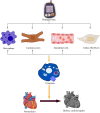Role of pyroptosis in diabetic cardiomyopathy: an updated review
- PMID: 38250736
- PMCID: PMC10796545
- DOI: 10.3389/fendo.2023.1322907
Role of pyroptosis in diabetic cardiomyopathy: an updated review
Abstract
Diabetic cardiomyopathy (DCM), one of the common complications of diabetes, presents as a specific cardiomyopathy with anomalies in the structure and function of the heart. With the increasing prevalence of diabetes, DCM has a high morbidity and mortality worldwide. Recent studies have found that pyroptosis, as a programmed cell death accompanied by an inflammatory response, exacerbates the growth and genesis of DCM. These studies provide a theoretical basis for exploring the potential treatment of DCM. Therefore, this review aims to summarise the possible mechanisms by which pyroptosis promotes the development of DCM as well as the relevant studies targeting pyroptosis for the possible treatment of DCM, focusing on the molecular mechanisms of NLRP3 inflammasome-mediated pyroptosis, different cellular pyroptosis pathways associated with DCM, the effects of pyroptosis occurring in different cells on DCM, and the relevant drugs targeting NLRP3 inflammasome/pyroptosis for the treatment of DCM. This review might provide a fresh perspective and foundation for the development of therapeutic agents for DCM.
Keywords: NLRP3 inflammasome; diabetic cardiomyopathy; inflammation; mechanism; pyroptosis.
Copyright © 2024 Wang, Ma, Huang, Zhong, Lu and Li.
Conflict of interest statement
The authors declare that the research was conducted in the absence of any commercial or financial relationships that could be construed as a potential conflict of interest.
Figures



Similar articles
-
NLRP3 Inflammasome/Pyroptosis: A Key Driving Force in Diabetic Cardiomyopathy.Int J Mol Sci. 2022 Sep 13;23(18):10632. doi: 10.3390/ijms231810632. Int J Mol Sci. 2022. PMID: 36142531 Free PMC article. Review.
-
The Role of NLRP3 Inflammasome in Diabetic Cardiomyopathy and Its Therapeutic Implications.Oxid Med Cell Longev. 2022 Sep 6;2022:3790721. doi: 10.1155/2022/3790721. eCollection 2022. Oxid Med Cell Longev. 2022. PMID: 36111168 Free PMC article. Review.
-
NLRP3 gene silencing ameliorates diabetic cardiomyopathy in a type 2 diabetes rat model.PLoS One. 2014 Aug 19;9(8):e104771. doi: 10.1371/journal.pone.0104771. eCollection 2014. PLoS One. 2014. PMID: 25136835 Free PMC article.
-
Pyrroloquinoline quinone ameliorates diabetic cardiomyopathy by inhibiting the pyroptosis signaling pathway in C57BL/6 mice and AC16 cells.Eur J Nutr. 2022 Jun;61(4):1823-1836. doi: 10.1007/s00394-021-02768-w. Epub 2022 Jan 8. Eur J Nutr. 2022. PMID: 34997266 Free PMC article.
-
Attenuation of ROS/Chloride Efflux-Mediated NLRP3 Inflammasome Activation Contributes to Alleviation of Diabetic Cardiomyopathy in Rats after Sleeve Gastrectomy.Oxid Med Cell Longev. 2022 Apr 19;2022:4608914. doi: 10.1155/2022/4608914. eCollection 2022. Oxid Med Cell Longev. 2022. PMID: 35498125 Free PMC article.
Cited by
-
Diabetic cardiomyopathy: Importance of direct evidence to support the roles of NOD-like receptor protein 3 inflammasome and pyroptosis.World J Diabetes. 2024 Aug 15;15(8):1659-1662. doi: 10.4239/wjd.v15.i8.1659. World J Diabetes. 2024. PMID: 39192865 Free PMC article.
-
Diabetic Cardiomyopathy-From Basics through Diagnosis to Treatment.Biomedicines. 2024 Mar 29;12(4):765. doi: 10.3390/biomedicines12040765. Biomedicines. 2024. PMID: 38672121 Free PMC article. Review.
-
Role of the NLRP3 inflammasome in diabetes and its complications (Review).Mol Med Rep. 2025 Nov;32(5):292. doi: 10.3892/mmr.2025.13657. Epub 2025 Aug 24. Mol Med Rep. 2025. PMID: 40849818 Free PMC article. Review.
-
Pyroptosis in Diabetic Peripheral Neuropathy and its Therapeutic Regulation.J Inflamm Res. 2024 Jun 14;17:3839-3864. doi: 10.2147/JIR.S465203. eCollection 2024. J Inflamm Res. 2024. PMID: 38895141 Free PMC article. Review.
-
Teneligliptin mitigates diabetic cardiomyopathy through inflammasome inhibition: Insights from experimental studies.World J Diabetes. 2024 Dec 15;15(12):2370-2375. doi: 10.4239/wjd.v15.i12.2370. World J Diabetes. 2024. PMID: 39676805 Free PMC article.
References
-
- Type 1 diabetes mellitus. Nature Reviews Disease Primers. Available at: https://www.nature.com/articles/nrdp201716 (Accessed November 9, 2023).
-
- Molecular and metabolic mechanisms of insulin resistance and β-cell failure in type 2 diabetes . Nature Reviews Molecular Cell Biology. Available at: https://www.nature.com/articles/nrm2327 (Accessed November 9, 2023). - PubMed
Publication types
MeSH terms
Substances
LinkOut - more resources
Full Text Sources
Medical

